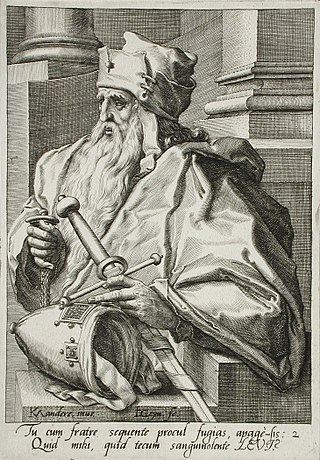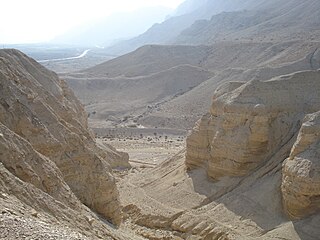In the Book of Exodus, Amram is the husband of Jochebed and father of Aaron, Moses and Miriam.

The Dead Sea Scrolls are ancient Jewish religious manuscripts discovered between 1946 and 1956 at the Qumran Caves in what was then Mandatory Palestine, near Ein Feshkha in the West Bank, on the northern shore of the Dead Sea. Dating from the 3rd century BCE to the 1st century CE, the Dead Sea Scrolls are considered to be a keystone in the history of archaeology with great historical, religious, and linguistic significance because they include the oldest surviving manuscripts of entire books later included in the biblical canons, along with deuterocanonical and extra-biblical manuscripts which preserve evidence of the diversity of religious thought in late Second Temple Judaism. At the same time they cast new light on the emergence of Christianity and of Rabbinic Judaism. Almost all of the 15,000 scrolls and scroll fragments are held by Israel in the Shrine of the Book at the Israel Museum. Israel's custody of the scrolls is disputed by Jordan and the Palestinian Authority on territorial, legal and humanitarian grounds – they were mostly discovered during the period of Jordanian control of the West Bank and captured by Israel in the 1967 Six Day War – whilst Israel's claims are primarily based on historical and religious grounds given their significance in Jewish history and in the heritage of Judaism.

The Book of Jubilees, sometimes called Lesser Genesis (Leptogenesis), is an ancient Jewish religious work of 50 chapters, considered canonical by the Ethiopian Orthodox Church as well as Beta Israel, where it is known as the Book of Division. Jubilees is considered one of the pseudepigrapha by Roman Catholic, Eastern Orthodox, and Protestant Churches. It is also not considered canonical within Judaism outside of Beta Israel.

Levi was, according to the Book of Genesis, the third of the six sons of Jacob and Leah, and the founder of the Israelite Tribe of Levi and the great-grandfather of Aaron, Moses and Miriam. Certain religious and political functions were reserved for the Levites.

According to the Bible, Jochebed was a daughter of Levi and mother of Miriam, Aaron and Moses. She was the wife of Amram, as well as his aunt. No details are given concerning her life. According to Jewish legend, she is buried in the Tomb of the Matriarchs, in Tiberias. In the New Testament, she is praised for her faith in God.

The Book of Giants is an apocryphal Jewish book which expands upon the Genesis narrative of the Hebrew Bible, in a similar manner to the Book of Enoch. Together with this latter work, the Book of Giants "stands as an attempt to explain how it was that wickedness had become so widespread and muscular before the flood; in so doing, it also supplies the reason why God was more than justified in sending that flood." The text's composition has been dated to before the 2nd century BC.

The Testaments of the Twelve Patriarchs is a constituent of the apocryphal scriptures connected with the Bible. It is believed to be a pseudepigraphical work of the dying commands of the twelve sons of Jacob. It is part of the Oskan Armenian Orthodox Bible of 1666. Fragments of similar writings were found at Qumran, but opinions are divided as to whether these are the same texts. It is generally considered apocalyptic literature.

According to the Torah, Kehath or Kohath was one of the sons of Levi and the patriarchal founder of the Kehathites, one of the four main divisions of the Levites in biblical times. In some apocryphal texts, such as the Testament of Levi and the Book of Jubilees, Levi's wife, Kehath's mother, is Milkah, a daughter of Aram.

The priesthood of Melchizedek is a role in Abrahamic religions, modelled on Melchizedek, combining the dual position of king and priest.

Józef Tadeusz Milik was a Polish biblical scholar and a Catholic priest, researcher of the Dead Sea Scrolls (DSS) through the deserts of Judea/Jordan, and translator and editor of the Book of Enoch in Aramaic (fragments).

4QMMT, also known as MMT, or the Halakhic Letter, is a reconstructed text from manuscripts that were part of the Dead Sea Scrolls discovered at Qumran in the Judean desert. The manuscripts that were used to reconstruct 4QMMT were found in Cave 4 at Qumran between the years 1953 and 1959. They were kept at the Palestinian Archaeological Museum, now known as the Rockefeller Museum in Jerusalem.
Discoveries in the Judaean Desert (DJD) is the official 40-volume publication that serves as the editio princeps for the Dead Sea Scrolls. It is published by Oxford University Press.

The Genesis Apocryphon (1Q20), also called the Tales of the Patriarchs or the Apocalypse of Lamech and labeled 1QapGen, is one of the original seven Dead Sea Scrolls discovered in 1946 by Bedouin shepherds in Cave 1 near Qumran, a small settlement in the northwest corner of the Dead Sea. Composed in Aramaic, it consists of four sheets of leather. Furthermore, it is the least well-preserved document of the original seven. The document records a pseudepigraphal conversation between the biblical figure Lamech, son of Methuselah, and his son, Noah, as well as first and third person narratives associated with Abraham. It is one of the nonbiblical texts found at Qumran. A range of compositional dates for the work have been suggested from the 3rd century BC to 1st century AD. Palaeography and Carbon-14 dating were used to identify the age of the documents. It is 13 inches in length and 2.75 inches in width at its widest point in the middle.

The Aramaic Enoch Scroll is a non-published, complete copy of the Book of Enoch which is rumored to be in possession of private investors.

4Q246, also known as the Son of God Text or the Aramaic Apocalypse, is one of the Dead Sea Scrolls found at Qumran which is notable for an early messianic mention of a son of God. The text is an Aramaic language fragment first acquired in 1958 from cave 4 at Qumran, and the major debate on this fragment has been on the identity of this "son of God" figure.
According to Judaism, the priestly covenant is the biblical covenant that God gave to Aaron and his descendants, the kohanim. This covenant consisted of their exclusive right to serve in the Temple, and to consume sacrificial offerings and receive other priestly gifts.

Discovered among the Dead Sea Scrolls near Qumran, Israel, were fragments of a scroll which describes New Jerusalem in minute detail. The New Jerusalem Scroll appears to contain an apocalyptic vision, an eschatological vision of the city and the temple, although, being fragmented, it is hard to categorize. Written in Aramaic, the text describes a vast city, rectangular in shape, with twelve gates and encircled by a long wall. Similar descriptions appear in Revelation 21–22 and comparison to the Temple Scroll shows many similarities despite no direct literary links between the two.

Visions of Amram, also referred to as 4Q543-549, is a collection of five extremely fragmented copies found in Qumran cave 4. In 1972, Jozef T. Milik published a significant fragment of the Visions of Amram. Since then, controversy has surrounded this document at every turn. In this testament, Amram gathers his sons, Moses and Aaron, to his deathbed and relates stories of his life, providing wisdom and commanding understanding. This document is named for a vision shared during this time.

The manuscript 4Q127 is one of the Dead Sea Scrolls. It is probably a paraphrase of Exodus according to the Septuagint (LXX) of the biblical Book of Leviticus, found at Qumran. The Rahlfs-No. is 802. Palaeographically it dates from the first century BC. Currently the manuscript is housed in the Rockefeller Museum in Jerusalem.


















